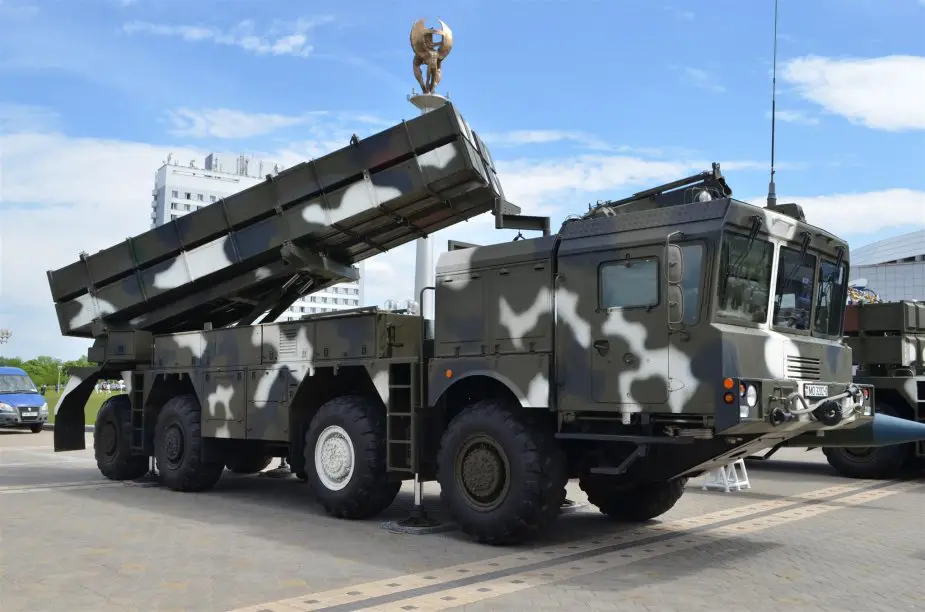In 2017, the export of Belarus armament increased by 15% in comparison with 2016, reaching more than $1bn sales despite problems in accessing Russian military orders, an unclear situation about cooperation with Ukraine and the reported disruption of a deal with Azerbaijan.

Palanez MLRS system, a programme dear to Belarus President Alexander Lukashenko (Picture source: Army Recognition)
The exports increase in 2017 demonstrates the contradictory balance between Minsk’s efforts to maintain neutrality and its efforts to maneuver between Moscow and Kiev, Baku and Yerevan, for instance. The Belarussian defense industries keep their position among the top-20 world arms sellers.
A combination of commercial success and prudence, Belarusian arms manufacturers have also diversified their client base. Last year, they sold products to 69 countries, compared to 60 in 2016. For instance, Minsk-based KB Radar could export its electronic warfare systems Groza-S and Optima-B, while the Barysau-based 140th Tank Repair Plant delivered its light-armoured vehicles, Kaiman and V-1, not only to the Belarusian army but also to an undisclosed African nation.
Last January on state TV, Belarusian businessmen and defense firm managers, including from Minotor-Servis and Integral, openly criticised Russia’s policy that aims to substitute Belarusian components in its military equipment. Furthermore, the chairman of the state military industrial committee, Aleh Dvihalyou, admitted on 31 January that Belarusian firms still face restrictions on receiving Russian state defense orders. He went further, saying that despite historical ties and the critical importance of Russian markets and partners for Belarus, only 54% of the ‘international interaction’ volume for Belarusian defense industries involves Russian firms. Aleh Dvihalyou did not specify what he meant under ‘interaction.’
46% of interactions involve non-Russian firms and, apparently, the committee did not calculate interaction with Ukraine. After all, on 1 February 2018, an unnamed representative of the committee talking to Nasha Niva weekly announced that military-technical cooperation with Ukraine had been halted as early as in 2014. Minsk allegedly stopped selling Kiev military equipment immediately after it started military operations in eastern Ukraine. This statement likely shows the wish to downplay respective contacts with Ukraine which undoubtedly continue, although Minsk most probably reclassified them in order not to irritate Russian chauvinists.
In addition to difficulties with Russia and Ukraine, Belarus recently needed to resolve controversies in its collaboration with Azerbaijan. Minsk renounced the deal it negotiated with Baku for the sale of Palanez multiple launch rocket systems (MLRS) because of Armenia’s intervention. Minsk would soon sell arms to Armenia instead, however the Belarusian government has no interest in disrupting such relations because of Armenia. Yerevan, by far the poorer of the Caucasus states, cannot replace Baku in the field of defense procurements.
Last year’s negotiations between the Belarusian and Azerbaijani presidents covered defense cooperation, certainly including the Palanez. Azerbaijan has an interest in such weapons to neutralise the Iskander ballistic missiles Armenia received last year.
Belarus tries to develop new products to counter problems in traditional markets. Talking to the BelTA news agency on 31 January, the state secretary of security council, Stanislau Zas’,revealed plans to produce new sophisticated arms. In particular, this year, defense industries are planning to complete the development of combat drones.
Above all, Minsk develops its defence industrial capacities in the area of rockets and missiles. Minsk started its missile programme from zero, probably not earlier than the 2010s. In the first half of 2018, Belarus is expected to test a new, completely Belarusian-made rocket for the Palanez MLRS. So far, Belarusians relied on rockets including some Chinese parts for this system.
In addition to replacing the remaining foreign components in the Palanez rockets, the designers are developing a new, Belarusian missile for the Soviet-designed Buk surface-to-air missile (SAM) system. It could be retro-fitted Soviet-designed air-to-air missile types R-60 and R-73 that Belarusian designers intend to use in a new version of the Buk SAM system. First, Belarusian company Belspetsvneshtechnika has modernised these missiles to extend their lifetime and efficiency. It has designed new modifications, R-60BM and R-73BM, to be launched also from land-based SAM systems.
If not successfully addressed, the commercial challenges faced by the the Belarusian defense industry could weaken the sector in the long term, even threaten its viability.















